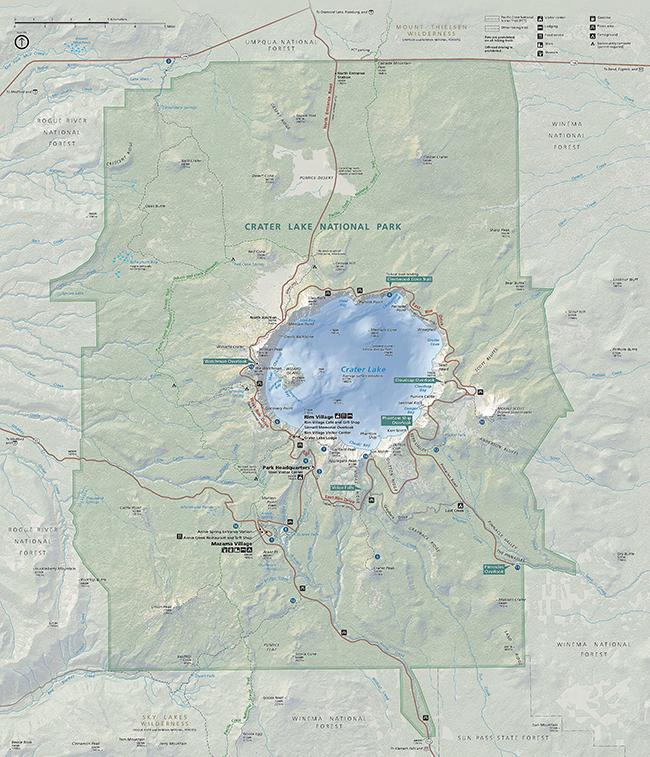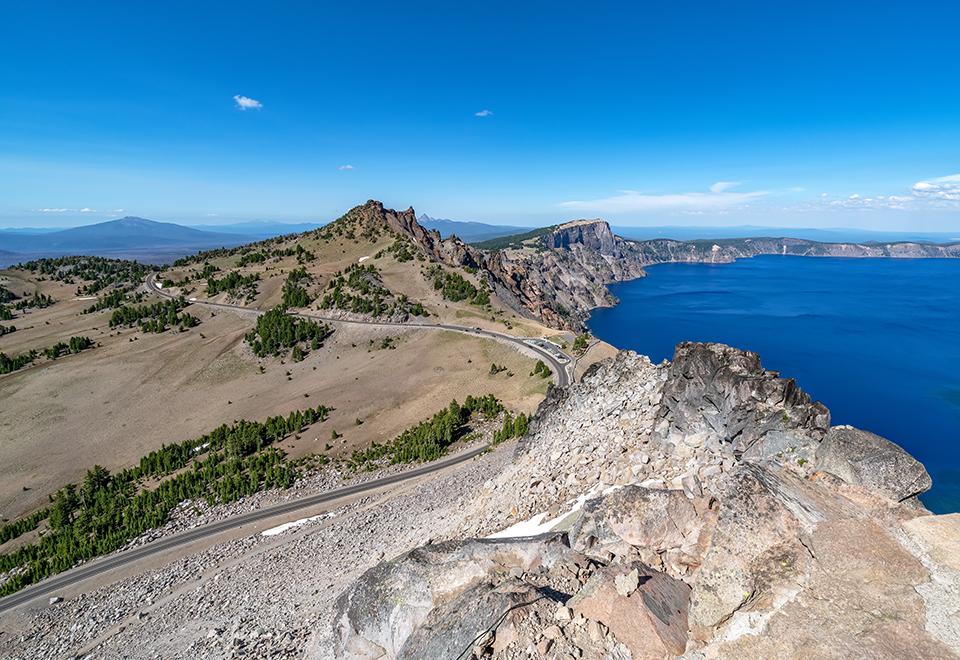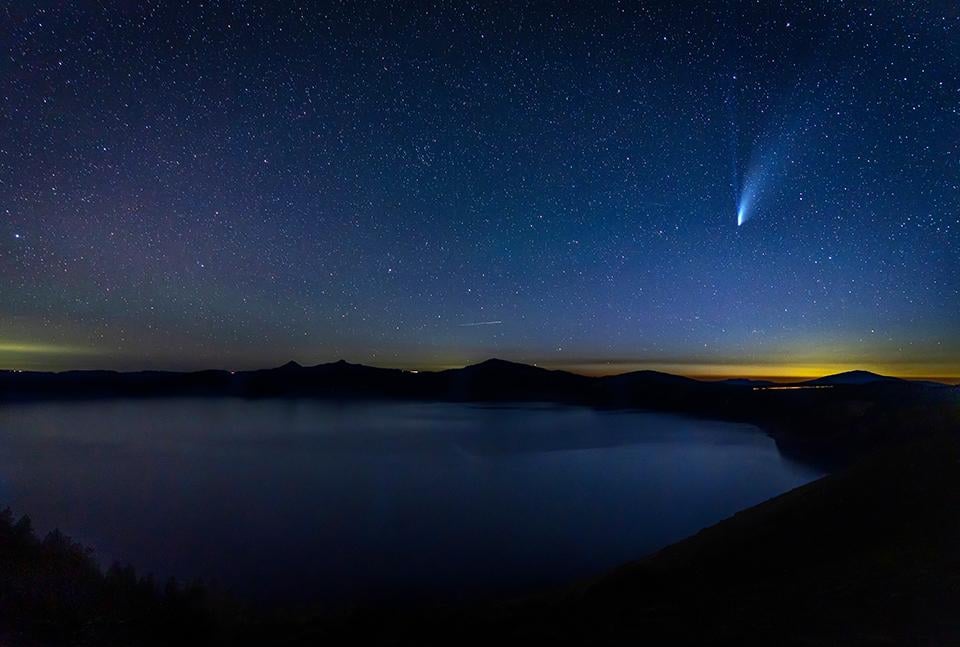
Blue water and blue sky, Crater Lake National Park / Rebecca Latson
The National Park Service has an apt description for this lake the native inhabitants considered so sacred and awe-inspiring that a person would die just by looking at it: “deep water in a sleeping volcano.” And that’s exactly what this Star of The Show is at Crater Lake National Park – deep (the deepest lake in the U.S.), impossibly blue water within the remnants of a volcano that blew its top off some 7,700 years ago and has been sleeping since. The Traveler’s Checklist for this park will help you plan your trip and make the most out of your visit.

Map of Crater Lake National Park / National Park Service
- There are three roads to the two park entrances. The south entrance is the only road open year-round. During the winter, it’s about a 4-hour drive from Portland International Airport to the south entrance (the north entrance is closed seven months of the year), and a little shorter during the summer because that north entrance will be open. A closer airport is the Rogue Valley International-Medford Airport to the south of the park, with a driving distance of a little more than an hour. It is a smaller airport, so flights are imited and you’ll have one or more plane changes along the way.
- There are a couple of in-park brick-and-mortar lodging choices: the Crater Lake Lodge and Mazama Village Cabins, both operated by Crater Lake Hospitality. The cabins are actually fourplexes with separate entrances, which are a nice pandemic lodging option if you don’t feel like wandering a hallway or enclosed indoor space. This option is about seven miles south of the crater rim. If you want something closer to the rim, then Crater Lake Lodge is the choice for you, with three different room types, depending upon how much you wish to splurge. The lodge houses 71 rooms available, so you’ll need to make your room reservations long before you actually travel to the park. Actually, the same can be said of the Mazama Village Cabins – make your reservations super-early.
- If you want to camp instead, try one of the two developed campgrounds: Mazama Campground and Lost Creek Campground, both open only in the summer. The Lost Creek Campground is for tent-only camping and registration is self-serve upon the day of arrival. Depending upon what time of the year you stay at the Mazama Campground, getting a site will either be first-come first-served, or via advanced reservation.
- There’s a single gas station within the park, located at Mazama Village. During the busy part of the summer, the gas tanks often run out and you might be waiting a day or more before you can gas up.
- Both Mazama and Rim villages offer places to eat and purchase souvenirs. Check the park’s website for more information on all the lodging/eating/internet connectivity/restroom options. Getting cell phone service was a little better at the higher points along the crater rim, for me.

Viewing a part of the Rim Road from the summit of Watchman Peak, Crater Lake National Park / Rebecca Latson
- First thing you should do upon arriving in the park is travel the 33-mile historic Rim Drive encircling the lake. There are 30 overlooks with plenty of parking for different views of the lake. Take your time at each overlook – there’s no hurry. The major overlooks are named and you’ll see them on your park map. Driving the entire road is a great way to scout locations for sunrise and sunset photography. Just remember to obey the rules of the road. Driving the rim is much slower than driving the interstate highway.
- As you travel the circumference of the lake, don’t ignore the non-rim portions, where you’ll view other geologic features such as pumice deserts and cinder cones.
- Speaking of sunrise and sunset, Sinnott Memorial Overlook and Watchman Overlook are great for watching (and photographing) the sunrise, and Palisade Point and Cloudcap Overlook are very nice for sunset viewing and photography.
- If you don’t feel like driving much, capture those great views while bicycling. Cycling around the lake means you’ll have more chance to notice the landscape around you, but you must remember to obey the same rules of the road as automobiles, including speed limits and stop signs.
- Stay up past dark and stargaze. The lake provides an amazing foreground beneath the stars and Milky Way. It’s a great spot for viewing and photographing other night phenomena, too, such as meteor showers and comets. For tips on night photography, click here.
- What’s a visit to Crater Lake without a little swimming or even a boat tour? Cleetwood Cove is the only legal access to the lakeshore and swimming. In the summer, there are eight daily boat tours and two daily shuttles to Wizard Island for a hike around this cinder cone rising from the water.
- Pack your fishing rod and tackle box and go fishing. Check here to find out what is and is not allowed, where you can fish within the park and what you might catch.
- Join up with a ranger program to learn about the park’s environment, history, and wildlife.
- If you visit during the summer, avoid experiencing congested, swollen-eyed misery by remembering to pack your allergy medicine. Summer days are hot and dry and hikers, bikers, and cars really kick up the dust in this park.
- If you visit during the winter, go snowshoeing or cross-country skiing. According to a Department of the Interior blog post about Crater Lake National Park, it’s one of the snowiest places in the U.S., with an annual average of 43 feet of snow. If you don’t feel like heading out on your own, there are ranger-guided snowshoe walks to get you out on the snow and teach you about how plants, animals, and people survive the harsh winter conditions. You can sled, downhill ski, and snowboard in the park, but that all is absolutely prohibited in the caldera. And, you won’t be able to drive very far in this park during the winter, but if you feel up to the challenge, you can use your snowshoes or cross-country skis to circle the crater. You’ll need a backcountry permit for that winter activity.
- Before you go on your trip, remember to check the park’s website to find out if and where pets are allowed and whether or not there are any closures or restrictions due to construction, weather, or Covid-19.
- As you make your trip plans, remember, the coronavirus pandemic is not over, yet. Per the National Park Service, whose parent organization is the Department of the Interior: “To protect the health of those who live, work, and visit America’s national parks, face masks are required in all NPS buildings and facilities. Masks are also required on NPS-managed lands when physical distancing cannot be maintained, including narrow or busy trails, overlooks, and historic homes.” So, travel safely, take some masks, practice social distancing and wash your hands often.

Comet NEOWISE over the dark lake, Crater Lake National Park / Rebecca Latson




 Support Essential Coverage of Essential Places
Support Essential Coverage of Essential Places







Comments
I've only been to Crater Lake once about forty years ago! The blue of the lake has to be seen seen to be believed. i and my friend were lucky that John Dobson and the Ssn Francisco Sidewalk Astronomers were around with varilus telescopes day and night. I saw sunspots, the rings of Saturn, and the Andromeda galaxy. John Dobson also gave a talk to a largely middle American audience. The folks just loved the entire experience.We also took a boat ride on the lake - don't pass it up. We did a lot of hiking and drove the entire rim road. We also a good meal at the Crater Lake Lodge, although we camped at Maza campground or was it the other one. Great trip.